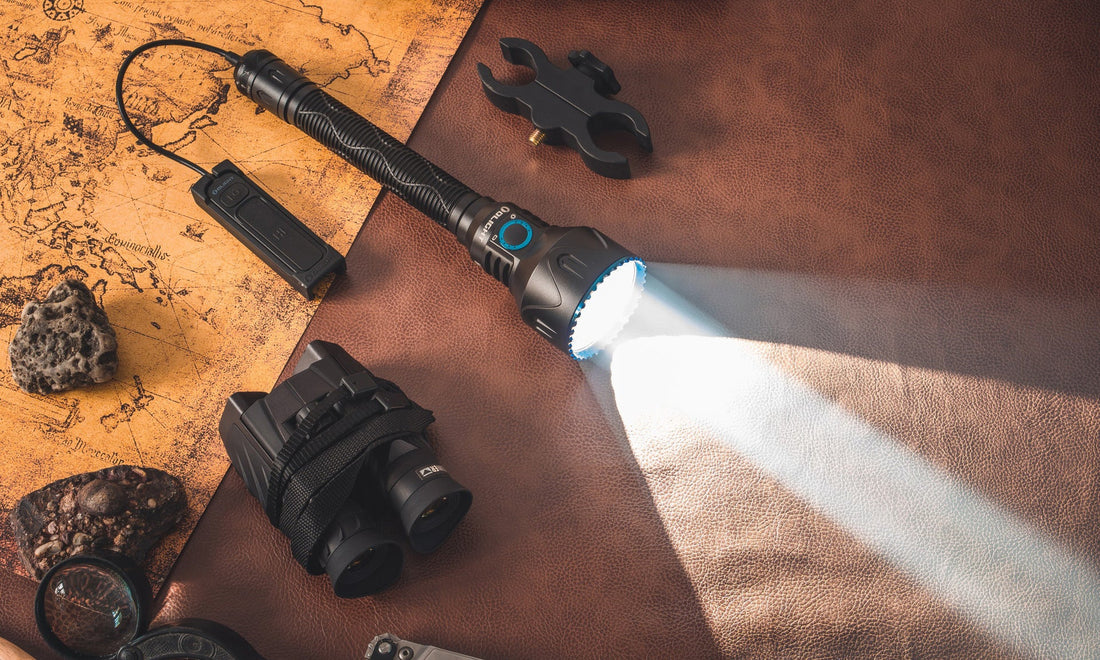
The Ultimate Guide to Flashlights: From Everyday Carry to Tactical Gear
Share
Flashlights have come a long way since their invention over a century ago. What was once a simple tool for illuminating dark spaces has evolved into a sophisticated piece of technology with countless applications. Whether you're an outdoor enthusiast, preparedness advocate, or just someone who wants to be prepared for power outages, understanding flashlights can help you make informed decisions about which one is right for your needs.
A Brief History of Flashlights
The first flashlight was invented in 1899 by British inventor David Misell. These early models used carbon-filament bulbs and zinc-carbon batteries, providing only a brief "flash" of light—hence the name "flashlight." The technology was rudimentary by today's standards, but it revolutionized portable lighting.
Over the decades, flashlight technology evolved dramatically. The introduction of tungsten filaments, alkaline batteries, and eventually LED technology transformed flashlights from unreliable novelties into essential tools for professionals and everyday users alike.
Understanding Flashlight Technology
Light Sources
Incandescent Bulbs: The traditional light source for flashlights, these work by heating a filament until it glows. They're less efficient than modern alternatives but provide warm, natural-looking light.
LED (Light Emitting Diodes): Most modern flashlights use LED technology. LEDs are highly efficient, durable, and long-lasting. They can produce incredibly bright light while consuming minimal power. The technology has advanced to the point where even tiny keychain lights can outperform large incandescent flashlights from just a decade ago.
HID (High-Intensity Discharge): These are less common in handheld flashlights but offer extremely high output. They're typically found in large, powerful searchlights.
Power Sources
Alkaline Batteries: Readily available and inexpensive, but performance drops significantly as they discharge. They're also prone to leaking when left in devices for extended periods.
Lithium Batteries: Offer better performance in extreme temperatures and have a longer shelf life. Lithium-ion batteries are rechargeable and power most high-performance flashlights.
Rechargeable Systems: Many modern flashlights feature built-in charging via USB, magnetic connectors, or docking stations. This convenience comes at the cost of reduced runtime when away from power sources.
Key Features to Consider
Lumens: Measures the total amount of visible light emitted. While important, lumen ratings don't tell the whole story—beam distance and focus are equally crucial.
Beam Distance: How far the light effectively illuminates. This is especially important for outdoor activities like hiking or search and rescue operations.
Runtime: How long the flashlight operates on a set of batteries or charge. Pay attention to whether the runtime is measured until complete shutdown or until light output drops to a specific level (often 10% of initial output).
Durability: Look for flashlights with robust construction, waterproof ratings (IPX7 or IPX8 for submersion), and impact resistance. Military specifications (MIL-STD-810) indicate rigorous testing for durability.
User Interface: Simple on/off switches versus complex multi-mode interfaces with various brightness levels, strobe functions, and SOS modes. Consider what you'll actually use regularly.
Types of Flashlights for Different Needs
Everyday Carry (EDC) Flashlights
These compact lights are designed for daily use. They're small enough to carry comfortably in a pocket or purse yet powerful enough for most tasks. Key considerations include:
-
Size and weight for comfortable carry
-
Sufficient brightness for urban environments (100-300 lumens typically adequate)
-
Simple operation with potentially a few brightness levels
-
Decent runtime for unexpected situations
Tactical Flashlights
Designed for law enforcement, military, and self-defense applications, these flashlights prioritize durability, maximum output, and specialized features:
-
High lumen output (often 500-1000+ lumens) for temporary disorientation
-
Crenulated bezels for defensive use
-
Momentary-on switches for signaling and brief illumination
-
Robust construction that can withstand impact and harsh conditions
-
Often include strobe functions for disorientation
Outdoor/Adventure Flashlights
Built for camping, hiking, and other outdoor activities, these lights balance output with runtime:
-
Multiple output modes to conserve battery when maximum brightness isn't needed
-
Good beam distance for trail navigation
-
Weather resistance for rain and moisture
-
Red light modes to preserve night vision
-
Potentially adjustable beams for flood versus spotlight use
Specialty Flashlights
This category includes right-angle lights (which can stand on their own or be worn as headlamps), lanterns for area lighting, and ultraviolet lights for detecting scorpions or verifying currency authenticity.
Maintenance and Care Tips
Proper maintenance ensures your flashlight performs when you need it most:
-
Regularly check batteries: Replace or recharge before they're completely depleted to avoid leakage or damage
-
Clean contacts: Use a cotton swab and rubbing alcohol to clean battery contacts if performance decreases
-
Inspect O-rings: These provide water resistance—ensure they're clean and lightly lubricated with silicone grease
-
Avoid extreme heat: Don't leave flashlights in hot cars, which can damage batteries and electronics
-
Store properly: Remove batteries if storing for extended periods, and keep in a cool, dry place
The Future of Flashlight Technology
Flashlight technology continues to advance rapidly. We're seeing developments in:
-
Smart features: Bluetooth connectivity, programmable interfaces, and integration with other devices
-
Improved efficiency: LEDs continue to become more efficient, providing more light with less power
-
Alternative power sources: Solar charging, hand cranks, and thermoelectric generators for emergency situations
-
Advanced materials: Lighter yet stronger composites and better thermal management for high-output lights
Conclusion
Whether you need a simple light for finding your keys in a dark purse or a powerful tool for search and rescue operations, there's a flashlight designed for your specific needs. By understanding the technology, features, and types available, you can select the perfect illumination tool for your requirements. Remember that the best flashlight isn't necessarily the brightest—it's the one that's with you when you need it and performs reliably in your specific situation.
What's your experience with flashlights? Do you have a favorite model or brand? Share your thoughts in the comments below!